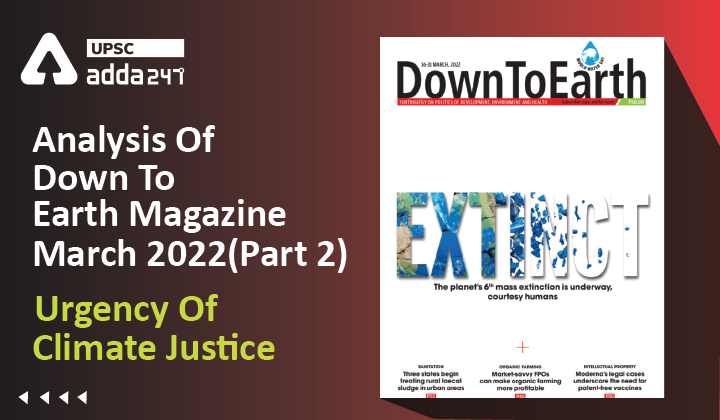Analysis Of Down To Earth Magazine: ”Urgency Of Climate Justice”
Relevance
GS 3: Environmental Pollution & Degradation
Context
- The Intergovernmental Panel on Climate Change (IPCC) has so far published two instalments of its Sixth Assessment Report (AR6).
- While the first report, “The Physical Science Basis” released in September 2021, unequivocally attributed extreme weather events to climate change.
- The latest report released on February 28 this year, lays bare that inequality makes certain communities and countries more vulnerable to climate change impacts. In this report, IPCC for the first time authoritatively states that climate justice now needs to be at the centre of global policy-making.
About IPCC
- Created in 1988 by the World Meteorological Organization (WMO) and the United Nations Environment Programme (UNEP), the objective of the IPCC is to provide governments at all levels with scientific information that they can use to develop climate policies.
- IPCC reports are also a key input into international climate change negotiations.
- The IPCC is an organization of governments that are members of the United Nations or WMO. The IPCC currently has 195 members.
Key Findings From IPCC’s Latest Report
- The report, “Climate Change 2022: Impacts, Adaptation and Vulnerability”, compiled by 270 authors from 67 countries, incorporating research from over 34,000 scientific papers, identifies 127 risks to natural and human systems.
- It notes that nearly half the global population now lives in settings that are “highly vulnerable to climate change.”
- Climate change disproportionately affects marginalised groups, amplifying inequalities and undermining sustainable development across all regions, it states with “high confidence”.
- The poor typically have low carbon footprints but are disproportionately affected by adverse consequences of climate change,” it states, adding that they lack access to adaptation options.
- The report identifies that the most vulnerable regions are located in Global South—East, Central and West Africa, South Asia, Micronesia and in Central America.
- These regions already reel from the compound challenges of high levels of poverty, inadequate ac- cess to basic services like water and sanitation, gender inequalities and poor governance.
- Providing the evidence base for the vulnerability of the Global South, the report states that observed average mortality from floods, drought and storms is 15 times higher for countries ranked as “very high” vulnerable, such as Mozambique, Somalia, Nigeria, Afghanistan and Haiti compared to “very low” vulnerable ones, such as the UK, Australia, Canada and Sweden in the last decade.
- Over 3.3 billion people live in countries classified as very highly or highly vulnerable, while 1.8 billion are in countries with low or very low vulnerability. Worse, the population in most vulnerable countries is projected to increase significantly by 2050 and 2100.
The future can be disastrous due to climate change
- While climate change is already causing more frequent and severe floods, heatwaves, wildfires and habitat destruction, the biggest impact will be on agricultural systems.
- Yields of major cereal crops in climate-affected areas are already significantly lower than they were, due to today’s current 1.1°C increase in global temperature averages above pre-industrial levels.
- If that number reaches 1.5°C, the target set out by the IPCC in an earlier report as the highest we can go before a total climate disaster, about 8 per cent of the world’s farmland would become unsuitable for agriculture.
- An increase of 2°C, or more, could be catastrophic, said Debra Roberts, one of the report’s co-chairs, in a press conference.
How Will Climate Change Impact the World?
- Without strong adaptation measures, losses and damages will likely be concentrated among the poorest vulnerable populations.
- Though the impact of crop failure will be felt worldwide, this will be particularly acute in Africa, Asia, Central and South America, on small island nations and in the Arctic.
- At 2°C of warming, people in sub-Saharan Africa, South Asia and Small Island Developing States will face severe food shortages and malnutrition.
- Even with moderate climate change, people in vulnerable regions will experience a further erosion of livelihood security that can interact with humanitarian crises, such as displacement and forced migration and violent conflict.
- Climate change is likely to force economic transitions among the poorest groups, accelerating the switch from agriculture to other forms of wage labour.
- The projected number of people living in extreme poverty may increase by 122 million by 2030.
- Climate change risks also carry the risk of amplifying or aggravating existing tensions within and between communities and countries.
What Should be Done?
- To deal with the impacts of climate change, farmers and agricultural systems will have to adapt, from adjusting growing seasons to switching crops or installing water-saving irrigation systems.
- Vulnerability reduction and adaptation to climate change have also to be seen as an issue of climate justice and climate-just development.
- Climate justice requires consideration of the legal, institutional and governance frameworks that significantly determine whether adaptation is successful in addressing the needs of the poor.



 TSPSC Group 1 Question Paper 2024, Downl...
TSPSC Group 1 Question Paper 2024, Downl...
 TSPSC Group 1 Answer key 2024 Out, Downl...
TSPSC Group 1 Answer key 2024 Out, Downl...
 UPSC Prelims 2024 Question Paper, Downlo...
UPSC Prelims 2024 Question Paper, Downlo...





